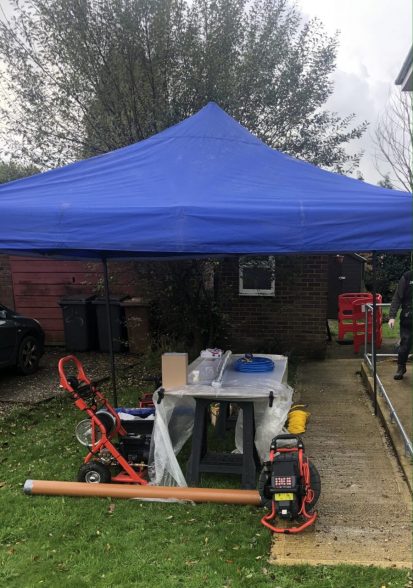
Lime plastering Wiltshire/ damp survey wiltshire
By: admin | Posted on: November 10, 2020
I was recently asked to carry out a damp investigation to a property where damp issues had persisted for many years. My client had received conflicting advice from a number of different damp and lime experts. Some of this advice was to remove any modern materials and replace with lime render and lime plaster. Remove modern paint, and repoint with lime pointing putty. Other advice was to use a modern guaranteed system and damp proof walls. Another free damp survey specified to increase the ventilation in the property by installing a positive input ventilation (piv).
In this instance this is where it can get very worrying, as potentially a serious amount of money is about to spent, and neither of this is actually going to fix the root cause. This is a common scenario when a homeowner is a layperson and has no knowledge of how a damp survey should be carried out. Lets face it most people that come around to a property have a service to offer, and im sure most people are just trying to earn a living without the intention of trying to rip anybody off.
This job could have gone horribly wrong if our client hadn’t been advised by a family friend just about before she was going to have the lime plastering and lime pointing carried out to her Wiltshire property. Her friend advised her to contact me as we’ve recently helped out another friend with a very similar conflicting rising damp issue.
The damp survey
The art of any damp investigation is all about elimination of the root cause before coming to a conclusion. The well documented BRE digest 245 methodology is what I would say an averagely competent damp surveyor should follow, and this should aid any survey findings. The reason I say this is because this methodology is recommended guidance in every British Standard in regards to damp. In this instance at this property the mortar sampling was very wet at the base of the wall (20% capillary moisture), along with a very low hygroscopic value (1.1%), with no high levels of nitrates or chlorides. By following this methodolgy and removing the plaster samples for analysis, I was able to confirm something that none of the previous surveyors, contractors, lime specialists had even mentioned.
All of this points to either a mains leaks, plumbing leak, or drainage leak. This high amount of capillary moisture, along with a very low amount of hygroscopic value, is indicative of rising damp caused by excess water from a defect. True genuine long term rising damp always has hygroscopic salts like chlorides, and / or nitrates present.
I used our signal generator Ridgid SR20 to actually locate and trace the mains water coming from the road and into the property. Because the property had been extended, the original main was hidden under new concrete solid floors to the side extension. Once this was located I was then able to use My Aquaphon acoustic leak detection equipment all the way along the pipe to listen for any possible mains water leaks.
The property had some older original drainage systems in place, and some fairly modern drainage. I used my Ridgid drain CCTV inspection camera to inspect all drains around the property.
What I found during the CCTV inspection was that the drains were in need of urgent repair, as these defects were directly related to the amount of moisture that was producing rising damp symptoms within the property. What was good, was that my client was there and could view the camera inspecting the drainage for all the issues that I noted.
I used a tracking dye and a bung to flood the drains to exaggerate the issue, to track the path of the water. What I also found was that this drainage issue also caused damp issues to the cavity construction part of the extension also, as I was able to see it within the cavity wall.
By using Complete Preservation for the initial survey, we were then trusted to specify the repairs to the building to resolve the rising damp issues.
As always budgets can be limited so quotations are really based on what needs to be done ASAP, and at what cost.
I specified drain patching, which was needed in numerous locations, along with connecting an old soak away to mains drainage, as this wasn’t draining as desired.
Ground levels were lowered as per our typical drawing.
Modern masonry paint is to be removed at low level (150mm from the floor) to aid evaporation at the base of the wall. Lime putty repointing was also specified for low level areas where pointing was needed.
Please see the below video of a 1 minute demo of how to remove modern masonry paint, and how to lower the high ground levels.
Top tip
Before you spend money on any damp proofing works, or even lime plastering, lime rendering, lime pointing in regards to damp issues, it would be worth paying for professional guidance to eliminate damp root causes. It would be prudent to have a CCTV drain survey, leak detection, and also mortar/plaster sampling following the methodology in BRE DIGEST 245 where needed. The reason I say this is because I’ve seen numerous lime plastering jobs fail because none of the above has been carried out. Lime plastering is a fantastic product, but it isn’t going to perform as desired when there are defective drains, and the walls are very wet. When walls are very wet it is also a good idea to use some drying equipment to lower the moisture content of the wall.
If you need further advice regarding damp issues and lime plastering costs please email enquiries@completepreservation.co.uk
